ZEITGEIST: THE MOVIE
COMPANION SOURCE GUIDE
This material is protected by the Creative Commons Attribution-Noncommercial-No Derivative Works 3.0 United States License.
Part One: The Greatest Story Ever Told
DIRECTOR’S NOTE:
Zeitgeist: The Movie - Part 1: “The Greatest Story Ever Told” presents historical data relating to the astronomi-
cal/astrological origins of the Judeo-Christian theology (which can be extended to Islam as well), along with
the understanding that these respective stories, beliefs & traditions are really an adaptation-extension of prior
Pagan beliefs. In other words, evidence shows that these modern religions are really composites of earlier
religions with their stories and symbolisms “borrowed” as the new traditions evolved. Of course, believers of
theistic religions have a inherent, self-preserving interest to disagree with such a notion, for it brings their reli-
gion out of the context of the supernatural and novel - and into the context of a singular, serial intellectual evo-
lution of information where many religions begin to share a common symbolic and literary basis. From such a
perspective, naturally, the idea that “Jesus” or “Osiris” or “Dionysus” were real, supernatural figures of a larger
order metaphysic becomes a distant reality. Regardless, this section isn’t really about whether “God” exists or
any such issue - it is about the firm reality that religions have been borrowing and building upon each other,
while the central origin of these theologies almost always comes back to stellar and solar fascination, in part.
When we track these literary/ritual characteristics, we find that most religions of the world have been spawned
from the interpretation/misinterpretation of the natural world and its dynamic phenomena. Of this phenomena,
it is found that the sun, the stars and the general stellar array have been a powerful source of allegorical and
hence mythological meaning since the dawn of humanity. The term to describe this is “Astrotheology” and it will
be explained in the pages that follow.
I want to thank D.M. Murdock, aka Acharya S, for her profound and deeply brave commitment to this complex
issue. She has been very kind to review and update the following data presented here. I would like to point out
that many who disagree with the following material often work to condemn the messenger as the originator.
Of course, this is a common tactic of those in denial or those who simply don’t have the interest to investigate
thoroughly. While Acharya is an expert in her field and does generate conclusions which are extrapolated from
the sources she researches - just as any good scholar should for the sake of progress - her work is also a pow-
erful collection of scholar/historian documentation which has occurred for the past 2000+ years. In other words,
the idea that all of these ideas about comparative religion are “Acharya’s ideas” is beyond incorrect. Again,
this is a tactic used by some to avoid actually reviewing sources. Another common accusation is that all these
ideas are from an “esoteric” egyptologist names Gerald Massey. This is also nonsense. Massey is simply one
of many Egyptologists who recognized the obvious relationship of Christianity to earlier religions, specifically
the Egyptian.
At end of this section is the Bibliography for Part 1. Everyone is encouraged to examine the sources denoted
and research the nature of those scholars. The fact is, while this topic has been very controversial and “taboo”
for a very long period of time, it doesn’t change the facts apparent - as inconvenient as they may be to the cur-
rent prevailing assumptions about the origins of modern religious beliefs.
A MESSAGE FROM DM MURDOCK:
When Peter Joseph asked me to help out on this lengthy project, I readily agreed, even though the material
contained herein had already been validated repeatedly in my other efforts. In this day and age, it is obvious
that many people are not inclined or available timewise to read large tomes of scholarly writings in order to “fig-
ure it all out.” This fact of time-constraint as well as difficulty in subject matter is the major reason “ZEITGEIST”
was so successful in the first place, as it provided a short and easily digestible summary of the issue at hand:
To wit, the origins of some of our most cherished religious ideas. So, here we have put together a resource
that is hopefully more readily available to all who are interested but find it difficult and time-consuming to wade
through huge chunks of information.
When Peter first asked me to pitch in on this specific project, he was not aware of how much work it would turn
out to be, because—as many who have read my work will know—I am very diligent and meticulous in not only
my writing style but also the subject matter.
In any event, as I try to do, I have put my all into this work, so I hope you will benefit from it greatly. This effort
includes new source material drawn from primary sources as well the works from credentialed authorities in a
variety of relevant subjects. - D.M. Murdock aka Acharya S
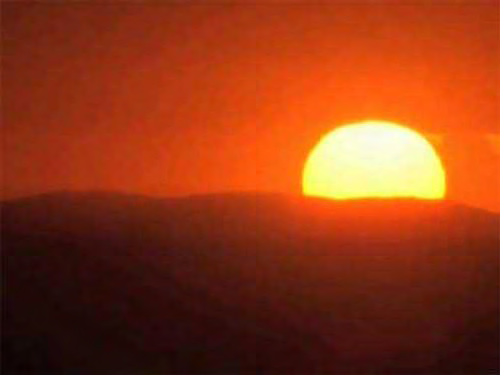
The Greatest Story Ever Told
1. This is the sun. As far back as 10,000 B.C., history is abundant with carvings and
writings reflecting people’s respect and adoration for this object.
Numerous artifacts prove these points, such as from the sun-worshipping cultures of the Egyptians,
Indians, Babylonians and Greeks, among many others, including the peoples of the Levant and ancient
Israel. Concerning the antiquity of sun worship, UNESCO Goodwill Ambassador Dr. Madanjeet Singh
relates:
The tool-making hominids, as anthropologists call them, emerged about one-and-a-half million
years ago. But the sun‘s identification with the animals they hunted became evident much later as
in the striking circular engravings representing the sun, discovered in the Central Asian regions
(thirteenth millennium BC) in Siberia and western Turkistan. They seem to have eventually
influenced the earliest artifacts made in Iran and Mesopotamia… Apart from the animals depicted
in the Lascaux caves in France, at Altamira in Spain, at Adduara in Sicily (15,000 to 10,000 BC),
and at the prehistoric Tassili N‘Ajjer in the Sahara region (7000 to 4000 BC), are also strange
human figures such as the dancing man with horns on his head and a stallion tail, as in the cave
paintings at Trois Frères in Ariège. These are comparable to similar figures seen on the third-
millennium-BC Mohenjo-daro seals found in the Indus Valley—symbols that are identified with the
sun….1
Describing this ubiquitous of sun worship, professor of Archaeology at Cardiff University Dr. Miranda J.
Aldhouse-Green remarks:
The evidence for the sun cult manifests itself in Europe from as long ago as the fourth millennium
BC, when Neolithic farmers recognized the divine power of the solar disc...
…Solar religion manifested itself not only in acknowledgement of the overt functions of the sun—
as a provider of heat and light—but also in recognition of influences that were more wide-
ranging…
1 Singh, 12-13.
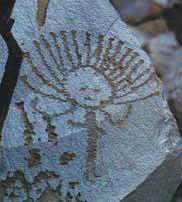
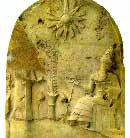

To early communities, the sun was an enigma, with its nightly disappearance from the sky and
the withdrawal of its heat for half the year. The sun‘s value as a life-force was revered….2
This solar religion continued for mil ennia, wel into the common or ―Christian‖ era. As stated by Dr. Lee
I.A. Levine, a professor at the Jewish Theological Seminary:
On the religious plane, belief in the supremacy of the sun god was widespread. The cult of Mithra,
as well as other Oriental cults in the late Roman era, identified the supreme deity with the sun. In
fact, the tendency in Late Antiquity to unify the creeds allowed [the Greek sun god] Helios to be
identified in many circles as the highest deity. On an intellectual level, Neoplatonic thought
throughout these centuries likewise addressed the centrality of the sun... Closer to Palestine, sun-
worship is amply attested...in Palmyra, among the Essenes, in Nabataea, as well as on a plethora
of coins, statuettes, altars, busts, and inscriptions from the first centuries of our era.3
Dr. Levine also says:
In the late Roman era, the figure of Helios, or Sol Invictus, occupied a central role in a variety of
settings, from the Imperial circles of Rome to the eastern provinces... Throughout the Greco-
Roman period generally, and especially in the first centuries of the Common Era, the cult of this
sun god enjoyed enormous popularity.4
Sun worship persists to this day, as described in Dr. Singh‘s The Sun: Symbol of Power and Life, an
extensive survey with many images of solar religious traditions and iconography from the earliest periods
into the modern era. For more information on the ―Astrotheology of the Ages‖ and ―The God Sun,‖ see
also Suns of God: Krishna, Buddha and Christ Unveiled by Acharya S/D.M. Murdock.
Irish ‗Sun Disc‘
‗Anthropomorphized sun-god images in
‗Babylonian King before the Sun God
c. 2000 BCE
Saimaly Tash rock drawings‘
Shamash,‘
(N. Museum of Ireland, Dublin)
Bronze Age (c. 3000-600 BCE)
c. 2000 BCE
Tien Mountains, Kyrgyzstan
(Musée du Louvre, Paris)
(Singh, 15)
2. And it is simple to understand why, as every morning the sun would rise, bringing
vision, warmth, and security, saving man from the cold, blind, predator-filled
darkness of night. Without it, the cultures understood, the crops would not grow, and
life on the planet would not survive. These realities made the sun the most adored
object of all time.
Concerning the ancient reverence for the sun, UNESCO Director-General Dr. Federico Mayor remarks:
As the bestower of light and life, ancient cultures generally identified the sun as the symbol of
Truth, the all-seeing ―one eye‖ of justice and equality, the fountainhead of wisdom, compassion,
and enlightenment, the healer of physical and spiritual maladies, and, above all, the fundamental
source of fecundity, growth, and fruition, as well as of death and the renewal of life.5
2 Singh, 295.
3 Kalmin, 106.
4 Kalmin, 103.
5 Singh, 7.

An Egyptian hymn from the era of the pharaoh Akhenaten (d. c. 1336 BCE) expresses the intense ancient
reverence for the sun:
You appear beautiful,
You living sun, lord of Endless Time,
are sparkling, beautiful and strong,
Love of you is great and powerful.
Your rays touch every face…
Your radiant skin animates hearts.
You have filled the Two Lands [of the horizons] with love of yourself.6
Pharaoh Akhenaten and wife Nefertiri worshipping the sun
c. 14th century BCE
3. Likewise, they were also very aware of the stars.
Naturally, the ancient practice of ―astrotheology‖ incorporated reverence for not only the sun but also the
moon, planets, stars and constellations. In Prehistoric Lunar Astronomy, Indian scholar Dr. S.B. Roy
remarks:
To the ancients...heaven was the land of gods and mystery. The sky...was itself living. The stars
were the abode of the gods. The shining stars were indeed themselves luminous gods.
Astronomy was the knowledge not of heavenly bodies, but of heavenly beings: It was the
heavenly, celestial cosmic or divine knowledge—knowledge of devas—the bright luminous gods.7
Ancient stellar symbols and star maps have been found dating to many thousands of years ago, including
in cave paintings and carvings. As the BBC reports in ―Ice Age star map discovered‖:
A prehistoric map of the night sky has been discovered on the walls of the famous painted caves
at Lascaux in central France.
The map, which is thought to date back 16,500 years, shows three bright stars known today as
the summer Triangle...
According to German researcher Dr. Michael Rappenglueck, of the University of Munich, the
maps show that our ancestors were more sophisticated than many believe.8
In ―‗Oldest Star Chart‘ Found,‖ astronomer Dr. David Whitehouse states:
The oldest image of a star pattern, that of the famous constellation of Orion, has been recognised
on an ivory tablet some 32,500 years old.
6 Assman, ESRNK, 94.
7 Roy, 1.
8 "Ice Age star map discovered," news.bbc.co.uk/2/hi/871930.stm
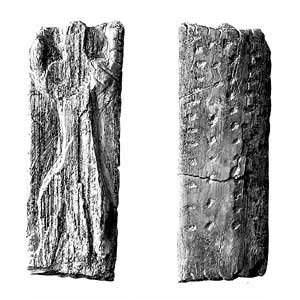
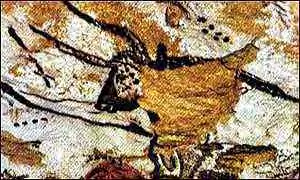
The tiny sliver of mammoth tusk contains a carving of a man-like figure with arms and legs
outstretched in the same pose as the stars of Orion....9
Ancient star map
Ivory star chart
c. 16,500 years old
c. 32,500 to 38,000 years old
Lascaux, France
Ach Valley, Alb-Danuba, Germany
4. The tracking of the stars allowed them to recognize and anticipate events which
occurred over long periods of time, such as eclipses and full moons. They in turn
catalogued celestial groups into what we know today as constellations.
In his book In Search of Ancient Astronomies, astronomer Dr. Edwin C. Krupp remarks:
At Stonehenge in England and Carnac in France, in Egypt and Yucatan, across the whole face of
the earth are found mysterious ruins of ancient monuments, monuments with astronomical
significance... Some of them built according to celestial alignments; others were actually precision
astronomical observatories... Careful observations of the celestial rhythms was compellingly
important to early peoples and their expertise, in some respects, was not equaled in Europe until
three thousand years later.10
One of these ancient observatories—one of the world‘s oldest yet discovered—is found in Goseck,
Germany:
A vast, shadowy circle sits in a flat wheat field near Goseck, Germany... The circle represents the
remains of the world‘s oldest observatory, dating back 7,000 years. Coupled with an etched disk
recovered last year, the observatory suggests that Neolithic and Bronze Age people measured
the heavens far earlier and more accurately than scientists had imagined.11
In ―Oldest solar Observatory in Americas Found in Peru,‖ NPR reports:
Archeologists may have uncovered what they say is by far the oldest astronomical observatory in
the America: a series of towers near a temple in coastal Peru, built in the fourth century B.C...
The towers at Chankillo mark the sun‘s progress across the sky... This suggests the sun may
have played an important role in religious and political life long before the appearance of the
famous Inca sun cult...
[Archeologist Ivan] Ghezzi says, ―The Inca claimed to be the offspring of the sun. But now we
have a society that is 1,800 years before the Inca that is clearly using the sun as a way to make a
political, social and ideological statement.‖
Many more such discoveries have occurred over the past several decades.
9 ―‗Oldest Star Chart‘ Found,‖ news.bbc.co.uk/2/hi/science/nature/2679675.stm
10 Krupp, ISAA, xiii.
11 Mukerjee, ―Circles for Space.‖ Mukerjee mentions here what is cal ed the ―Nebra Disk.‖
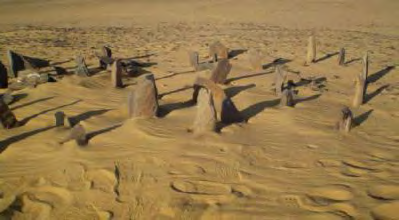
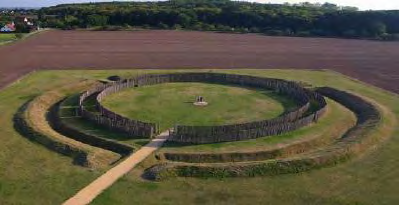
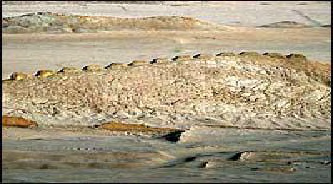
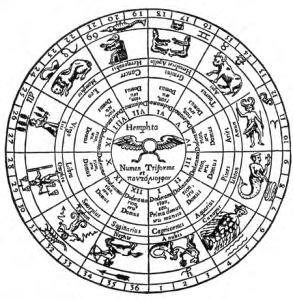
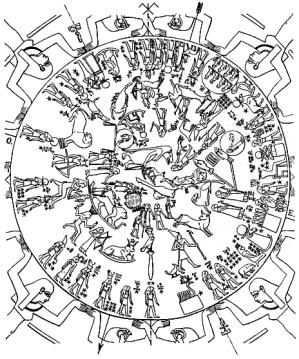
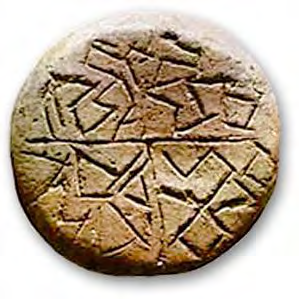
Solar circle observatory
Astronomically aligned stones,
c. 7,000 years old
The Thirteen Towers
6,000 to 8,500 years old
Goseck, Germany
c. 14th century BCE
Nabta Playa, Egypt
(Ralf Beutragel)
Chankillo, Peru
(Ivan Ghezzi)
5. This is the cross of the Zodiac, one of the oldest conceptual images in human history.
It reflects the sun as it figuratively passes through the 12 major constellations over
the course of a year. It also reflects the 12 months of the year, the four seasons, and
the solstices and equinoxes. The term Zodiac relates to the fact that constellations
were anthropomorphized, or personified, as figures, or animals.
The antiquity of the idea of a zodiac is disputed, but it may have been formulated as early as 4,000 or
more years ago. As D.M. Murdock says in Christ in Egypt: The Horus Jesus Connection:
…the zodiac certainly existed in Mesopotamia millennia ago, worked over by the famed Chaldean
astronomers, with the Greeks further polishing it. In this regard, several sources—such as royal
astronomer Dr. Edward Walter Maunder…, the devout Christian author of The Astronomy of the
Bible—have indicated an origin of the zodiac, including the popular signs, to some 4,000 or more
years ago. We also possess the relatively recent find of the ―Karanovo Zodiac‖ from Bulgaria,
which has been dated to around 6,000 years ago and which seems to bear rudimentary
renditions of the constellations found in the Western zodiac.12
The zodiac as it appears to us today was refined by the Greeks several centuries prior to the common
era.
Karanovo Tablet
―
c. 6,000 years old
Hieroglyphic Plan, by
Nova Zagora, Bulgaria
Hermes, of the Ancient
Dendera zodiac
Zodiac‖
1st century
(Kirchner, OEdipus
BCE
Dendera, Egypt
AEgyptiacus)
6. In other words, the early civilizations did not just follow the sun and stars, they
personified them with elaborate myths involving their movements and relationships.
The meanings of many myths can be traced to a number of origins, the most prominent of which is nature
worship and astrotheology, whereby the gods and goddesses are essentially personifications of earthly
forces and celestial bodies. As concerns the anthropomorphization of the celestial bodies, in Suns of
God: Krishna, Buddha and Christ Unveiled, Murdock relates:
12 Murdock, CIE, 265-266. The Karanovo Tablet has also been interpreted to be crude Egyptian hieroglyphs. See
―The Sacred Tablet from the village of Karanovo,‖ www.institutet-science.com/en/karanovoe.php
Ancient peoples abundantly acknowledged that their religions, dating back centuries and
millennia before the common era, were largely based on astrotheology, with their gods
representing the sun, moon, stars and planets. One of their focuses was the sun...and the story of
the sun became highly developed over a period of thousands of years, possibly tens of thousands
or more. The observations of the sun and its daily, monthly, annual and precessional movements
have led to complex myths in which it was personified as a god...13
We can see this astrotheological and nature-worshipping religion in the writings of ancient historians such
as Herodotus, Berossus and Diodorus, as well as in the Bible, both overtly and covertly, and in Jewish
apocryphal texts.14 The writings of the Church fathers also discussed the Pagan astrotheology,
sometimes fairly extensively.
One ancient source for the true nature-worshipping and astrotheological meaning of many Greek gods
and goddesses is the writer Porphyry (c. 235-c. 305 AD/CE), who (according to early Catholic Church
father/historian Eusebius) related:
The whole power productive of water [the Greeks] called Oceanus... the drinking-water produced
is called Achelous; and the sea-water Poseidon...
...the power of fire they called Hephaestus... the fire brought down from heaven to earth is less
intense...wherefore he is lame...
Also they supposed a power of this kind to belong to the sun and called it Apollo... There are also
nine Muses singing to his lyre, which are the sublunar sphere, and seven spheres of the planets,
and one of the fixed stars...
But inasmuch as the sun wards off the evils of the earth, they called him Heracles [Hercules]...
And they invented fables of his performing twelve labours, as the symbol of the division of the
signs of the zodiac in heaven; and they arrayed him with a club and a lion‘s skin, the one as an
indication of his uneven motion, and the other representative of his strength in ―Leo‖ the sign of
the zodiac.
Of the sun‘s healing power Asclepius is the symbol...
But the fiery power of his revolving and circling motion whereby he ripens the crops, is called
Dionysus... And whereas he revolves round the cosmical seasons [Grk. horas] and is the maker
of ―times and tides,‖ the sun is on this account called Horus.
Of his power over agriculture, whereon depend the gifts of wealth (Plutus), the symbol is Pluto...
Cerberus is represented with three heads, because the positions of the sun above the earth are
three—rising, midday, and setting.
The moon, conceived according to her brightness, they called Artemis...
What Apollo is to the sun, that Athena is to the moon: for the moon is a symbol of wisdom, and so
a kind of Athena.
But, again, the moon is Hecate, the symbol of her varying phases...
They made Pan the symbol of the universe, and gave him his horns as symbols of sun and moon,
and the fawn skin as emblem of the stars in heaven, or of the variety of the universe.15
Porphyry‘s explanations include many other divine figures, relating them to additional nature-worshipping
elements such as air, wind, fruits and seeds, and he names the earth as a virgin and mother:
In all these ways, then, the power of the earth finds an interpretation and is worshipped: as a
virgin and Hestia, she holds the centre; as a mother she nourishes...16
13 Acharya, SOG, 60.
14 For more on these subjects, see Murdock/Acharya‘s Suns of God.
15 Eusebius, Evangelicae Praeparationis (―The Preparation for the Gospel‖), III, XI, 112d-115a; Eusebius/Gifford, 122-
125.
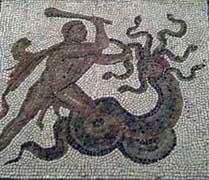
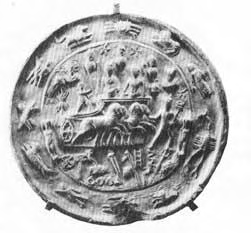
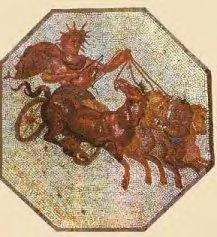
Here is clearly one source in antiquity of the virgin-mother concept, which was so obviously adopted into
Christianity from Paganism. As can be seen, the Greek religion was perceived in ancient times to be
highly astrotheological and reflective of nature worship. The same can be said of many others, such as
the Babylonian, Egyptian, Indian and Roman.
Hercules and the Hydra
Disk with Dionysus and 11 signs of the
Rom



















